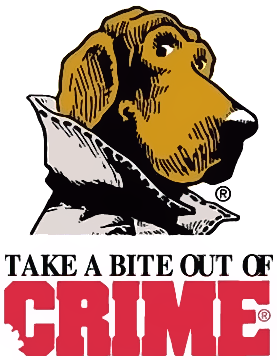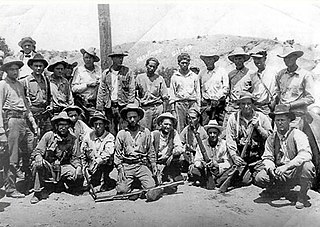
The United States Department of Health and Human Services (HHS) is a cabinet-level executive branch department of the U.S. federal government created to protect the health of the U.S. people and providing essential human services. Its motto is "Improving the health, safety, and well-being of America". Before the separate federal Department of Education was created in 1979, it was called the Department of Health, Education, and Welfare (HEW).
The Uniform Crime Reporting (UCR) program compiles official data on crime in the United States, published by the Federal Bureau of Investigation (FBI). UCR is "a nationwide, cooperative statistical effort of nearly 18,000 city, university and college, county, state, tribal, and federal law enforcement agencies voluntarily reporting data on crimes brought to their attention".

McGruff the Crime Dog is an anthropomorphic animated bloodhound created by Dancer Fitzgerald Sample advertising executive Jack Keil through the Ad Council and later the National Crime Prevention Council to increase crime awareness and personal safety in the United States. McGruff costumes are used by police outreach efforts, often with children. McGruff was created in 1979 and debuted in 1980 with a series of public service announcements educating citizens on personal security measures, such as locking doors and putting lights on timers, in order to reduce crime. His name was selected as part of a nationwide contest in July 1980.
Neighborhood watch is a citizens' organization devoted to crime prevention within a neighborhood.

A neighborhood watch or neighbourhood watch, also called a crime watch or neighbourhood crime watch, is an organized group of civilians devoted to crime and vandalism prevention within a neighborhood.

The Medical Reserve Corps (MRC) is a network in the U.S. of community-based units initiated and established by local organizations aimed at meeting the public health needs of their communities. It is sponsored by the Administration for Strategic Preparedness and Response (ASPR) of the United States Department of Health and Human Services (HHS). The MRC consists of medical and non-medical volunteers who contribute to local health initiatives, such as activities meeting the Surgeon General's priorities for public health, and supplement existing response capabilities in times of emergency. The MRC provides the structure necessary to pre-identify, credential, train, and activate medical and public health volunteers.

The Alaska State Troopers, officially the Division of Alaska State Troopers (AST), is the state police agency of the U.S. state of Alaska. It is a division of the Alaska Department of Public Safety (DPS). The AST is a full-service law enforcement agency that handles both traffic and criminal law enforcement. The AST is also involved in apprehending fugitives as part of the Alaska Fugitive Task Force, an inter-agency collaborative of Alaska police departments that cooperates with police agencies throughout the United States and less commonly with Interpol in apprehending wanted men and women. Unlike many lower 48 states, the AST also serves as Alaska’s primary environmental law enforcement agency; troopers assigned to the AST’s Division of Alaska Wildlife Troopers are known as "Alaska Wildlife Troopers" and primarily serve as game wardens, although they retain the same powers as other Alaskan state troopers.

As of 2020, more than 800,000 sworn law enforcement officers have been serving in the United States. About 137,000 of those officers work for federal law enforcement agencies.

The National Sheriffs' Association (NSA) is a U.S. trade association. Its stated purpose is to raise the level of professionalism among U.S. sheriffs, their deputies and others in the fields of criminal justice and public safety. Since its founding in 1940, NSA has been the advocacy organization for the nation's sheriffs in Washington, D.C. Its Government Affairs Division, in conjunction with the Congressional Affairs Committee, develops the Association's policy positions and represents the Association before the United States Congress, the White House, and the various federal agencies.
Citizen Corps is a program under the Department of Homeland Security that provides training for the population of the United States to assist in the recovery after a disaster or terrorist attack. Each local Citizen Corps Council partners with organizations, volunteers and businesses to organize responders, volunteers and professional first responders for an efficient response so efforts are not wasted by being duplicated. By training in Incident Command, volunteers know whom to report to and how the incident is organized. This prevents sites from being inundated by untrained and unprepared personnel preventing operation. Citizen Corps also works in conjunction with the Corporation for National and Community Service in promoting national service opportunities for promoting homeland security needs.
A community service officer (CSO) provides support in crime prevention, investigation, and response where full police powers are unnecessary and assists police officers in upholding law and order.
Title 34 of the United States Code is a non-positive law title of the United States Code with the heading "Crime Control and Law Enforcement." Released on September 1, 2017, by the Office of the Law Revision Counsel of the United States House of Representatives, it contains "crime control and law enforcement programs or activities in which the Attorney General or the Department of Justice have been given primary responsibility." Much of the law transferred to Title 34 were laws editorially classified to sections of Title 42 or set out as notes to Titles 42, 18, and 28.
An incident response team (IRT) or emergency response team (ERT) is a group of people who prepare for and respond to an emergency, such as a natural disaster or an interruption of business operations. Incident response teams are common in public service organizations as well as in other organizations, either military or specialty. This team is generally composed of specific members designated before an incident occurs, although under certain circumstances the team may be an ad hoc group of willing volunteers.
CaliforniaVolunteers is the state agency charged with increasing the number and impact of Californians engaged in service and volunteering.

The posse comitatus, frequently shortened to posse, is in common law a group of people mobilized by the conservator of peace – typically a reeve, sheriff, chief, or another special/regional designee like an officer of the peace potentially accompanied by or with the direction of a justice or ajudged parajudicial process given the imminence of actual damage – to suppress lawlessness, defend the people, or otherwise protect the place, property, and public welfare. The posse comitatus as an English jurisprudentially defined doctrine dates back to ninth-century England and the campaigns of Alfred the Great simultaneous thereafter with the officiation of sheriff nomination to keep the regnant peace. There must be a lawful reason for a posse, which can never be used for lawlessness.

Homeland Security Grant Program (HSGP) is a program in the United States established in 2003 and was designated to incorporate all projects that provide funding to local, state, and Federal government agencies by the Department of Homeland Security. The purpose of the grants is to purchase surveillance equipment, weapons, and advanced training for law enforcement personnel in order to heighten security. The HSGP helps fulfill one of the core missions of the Department of Homeland Security by enhancing the country's ability to prepare for, prevent, respond to and recover from potential attacks and other hazards. The HSGP is one of the main mechanisms in funding the creation and maintenance of national preparedness, which refers to the establishment of plans, procedures, policies, training, and equipment at the Federal, State, and local level that is needed to maximize the ability to prevent, respond to, and recover from major events such as terrorist attacks, major disasters, and other emergencies. The HSGP's creation stemmed from the consolidation of six original projects that were previously funded by the Office of State and Local Government Coordination and Preparedness. The HSGP now encompasses five projects in the program: State Homeland Security Program, Urban Areas Security Initiative, Operation Stonegarden, Metropolitan Medical Response System Program, and Citizen Corps Program. During the 2010 fiscal year, the Department of Homeland Security will spend $1,786,359,956 on the Homeland Security Grant Program.
Fire Corps is an American volunteer program which is designed to connect community members with their local fire/EMS departments to help with non-emergency tasks. This includes fire prevention education, administration, providing canteen services at incidents, vehicle and equipment maintenance, fundraising, translation services, preplanning assistance, and more. On a national level, Fire Corps is managed by the National Volunteer Fire Council.
The Pima County Sheriff's Department (PCSD) is an American law enforcement agency that serves the unincorporated areas of Pima County, Arizona. It serves the seventh largest county in the nation. It operates six district offices and three smaller satellite offices. The Corrections Bureau has four facilities which houses on average 1,850 inmates per day.
Citizens patrol is policing based on the concept that police officers and private citizens work together to solve community related problems. Some problems include crime, safety, fear and neighborhood decay. Many forms of Citizens Patrol have been in the U.S for quite some time. Most civilian patrols have been extensions for regular police patrols controlled and sanctioned by the police.









